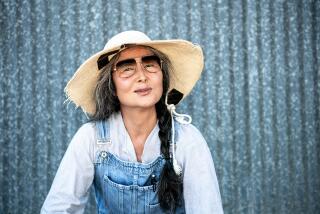The nourishment of body and spirit
Man does not live by bread alone. The same goes for rice, if it’s thought of in strictly nutritional terms.
An instructive exhibition at the UCLA Fowler Museum of Cultural History demonstrates that the popular grain has provided a lot more than bodily nourishment for the diverse peoples who have been eating it every day for the last 10,000 years. “The Art of Rice: Spirit and Sustenance in Asia” links farming and art to show that the cultivation of this hardy crop has had a remarkably civilizing influence on a large swath of humanity.
For millenniums, growing rice has gone hand-in-hand with the cultivation of an impressive variety of religious myths, social rituals and festive celebrations. Planting, harvesting, storing, cooking and eating rice also have led to the invention of all sorts of useful tools, and to the creation of a wide range of decorative artifacts -- some functional, many symbolic, most both.
More than 200 of these multipurpose objects are displayed in 11 small, interlinked galleries. Interspersed among them are informative wall labels, three documentary videotapes and a dozen National Geographic-style photographs.
The vast inventory of images and implements comes from Burma, Cambodia, China, India, Indonesia, Japan, Korea, Laos, Nepal, Sri Lanka, Thailand, Vietnam and the Philippines. The earliest rice-themed pieces are two squat, three-legged vessels from China’s Shang dynasty (1776-1122 BC). Made of bronze or ceramic, each is adorned with elaborate abstract patterns. The newest item is this year’s model of an electric rice cooker from Japan. Its digital gauges and aerodynamic style make it look as if it’s been beamed down from outer space.
All three pots -- and everything in between -- were selected by Roy Hamilton, the Fowler’s curator of Asian and Pacific collections. Over the last six years, he has enlisted the assistance of an global team of 27 anthropologists, historians, sociologists, musicians, artisans, painters and curators -- along with a puppet master from Tumpang, East Java, and a librarian from the National Museum of Ethnology in Leiden, the Netherlands.
The result is a surprisingly coherent exhibition that is as far-reaching and ambitious as it is focused and accessible. Its amazing variety of materials from different times, places and peoples conveys a joyous, something-for-everyone outlook. Its fundamental point -- that rice civilizes -- is so simple and sensible that it brings great clarity to the whole project.
Although “The Art of Rice” includes some rare and precious objects, the majority of its pieces are mundane and humble. Made of inexpensive, readily available materials, they were used daily by ordinary folks. Even the finely crafted offering bowls, ceremonial mortars and religious talismans were functional, in that they helped increase productivity by promoting social unity.
A few examples of concentrated wealth stand out. Just inside the entrance stands a large folding screen that depicts a lush field of rice plants extending to the horizon. Crafted in Japan in the early 19th century, its gold-leafed surfaces and elegant brushwork are so fragile that it will be displayed for only 10 weeks. Ten woodblock prints, from the reign of Emperor Yongzheng (1723-1735) during China’s Qing dynasty, will replace it. They illustrate the various stages of rice farming, capturing the seasonal rhythms of germinating, harrowing, transplanting, irrigating, harvesting, threshing, storing and giving thanks.
In the first four galleries, plain farm tools are juxtaposed with extraordinary ones. A water scoop from Vietnam, a winnowing fan from Thailand and a pair of shoulder baskets from the Philippines, all made of bamboo, bespeak the no-nonsense simplicity of utilitarian design. In contrast, eight hand-held knives, carved from wood, horn and bone, have elaborate handles shaped like wild boars, serpents and dragons -- or purely abstract patterns. Some are designed to cut single stalks of rice, ensuring that not a grain is harvested before its time.
Interspersed among the tools are 2,000-year-old ceramic funerary objects from China’s Han dynasty, an embroidered silk cloth from Japan’s Edo period (1603-1868) and a Balinese painting from the 1930s. Like fantastic storyboards in which each scene unfolds simultaneously, these works depict the many stages of rice farming with century-spanning consistency.
Among the most playful pieces are three Vietnamese water puppets representing farmers at work in irrigated fields. Six homemade dolls, woven from dried palm leaves in Bali, Indonesia, are about the same size. But they serve far different purposes. Some represent Grandmother Rice. Others are hermaphrodites. All symbolize fertility and are hung in rice fields, outside houses and in granaries to provide protection.
The next three galleries focus on the ways communities store supplies of rice; give thanks at the end of the season (in lively public parties); and build small shrines in their homes, where they pray to different deities.
The first features pragmatic storage bins and ritual objects, such as stylized horses, giant lizards and human figures, all of which guard the stockpiled grain. The highlight of the second gallery is a set of pink, yellow and green festival lanterns that are functional and -- made of rice flour and food coloring -- edible. The third includes carved wood figures and foxes that portray Japanese food gods, woven Balinese figurines that border on being geometric abstractions, images of Indian grain goddesses painted on pot lids and four fantastic Balinese deities.
The next gallery, dedicated to food and drink, steals the show. It’s the largest and most beautifully installed.
In it are juxtaposed the ancient Chinese vessels and the futuristic Japanese rice cooker, alongside ingenious steamers, griddles, mortars, mallets and signs advertising various shops and bars. Multi-tiered serving dishes from Japan, some inlaid with shells and others finished in glossy lacquers, share space with seven Burmese offering containers. Made of lathe-turned wood and lacquered basketry, these round vessels resemble towering temples or symmetrical stupas whose spires reach heavenward.
Another highlight is a vitrine filled with 11 gorgeously glazed stoneware sake bottles from the 18th and 19th centuries. But the centerpiece is an ornate altar on which four fabulously detailed statues enact a scene from Indian mythology. Blue-skinned Annapurna kneels to offer rice to yellow-skinned Shiva, who sits on a throne between porcelain-skinned Bhringi and dark gray Nandi. Each 3-foot-tall manikin wears meticulously sewn clothing and is adorned with a thick mane of artificial hair that looks better than the real thing.
The next gallery features mats, sandals, baskets, boots, rain capes, back pads and sacred altar ornaments. All are woven from the straw that’s left over when rice is harvested. Don’t miss the set of four snowshoes that some well-cared-for Japanese cows wear in the winter. What they lack in style, they make up for in comfort.
In the last two galleries, the exhibition takes a polemical turn. Although the penultimate room contains some fine objects -- including batik fabrics, a carved wood sculpture representing a wedded couple and a long interior wall of a Javanese home -- it has the presence of an afterthought or catch-all for leftovers. The argument put forth in its wall labels, that a season of rice farming matches the stages of a person’s life, repeats ideas better illustrated elsewhere.
But this gallery functions as a conceptual bridge to the final one, which is titled “The Future of Rice.” Here, wall labels inform visitors that in 1966, the International Rice Research Institute produced IR8, a modern high-yield variety of rice. This genetically engineered invention diminished the threat of starvation for millions of people by allowing subsistence farming to be replaced by commodity production.
Unfortunately, it simultaneously shattered the organic rhythms and plodding intimacy of old-fashioned farming. Such social aspects were the basis for the mythical, religious and artistic side of rice, all of which took form in the fascinating objects in the previous 10 galleries.
“The Art of Rice” ends on a melancholic note. In the final gallery, a handcrafted set of Indonesian shadow-puppets looks fragile and otherworldly, as if each of its colorful characters and powerful deities belongs to a long-lost dream world.
Three contemporary paintings by artists from Korea and the Philippines give visitors an idea of what it’s like to live by rice alone. Their grim realism contrasts dramatically with the celebratory verve and unsentimental utilitarianism of everything else in the show.
*
‘The Art of Rice: Spirit and Sustenance in Asia’
Where: UCLA Fowler Museum of Cultural History, UCLA Campus, Sunset and Westwood boulevards, Westwood
When: Wednesdays-Sundays, noon-5 p.m.; Thursdays, noon-8 p.m. Closed Mondays-Tuesdays
Ends: April 25
Price: Free; parking $7 (Lot 4)
Contact: (310) 825-4361
More to Read
The biggest entertainment stories
Get our big stories about Hollywood, film, television, music, arts, culture and more right in your inbox as soon as they publish.
You may occasionally receive promotional content from the Los Angeles Times.










